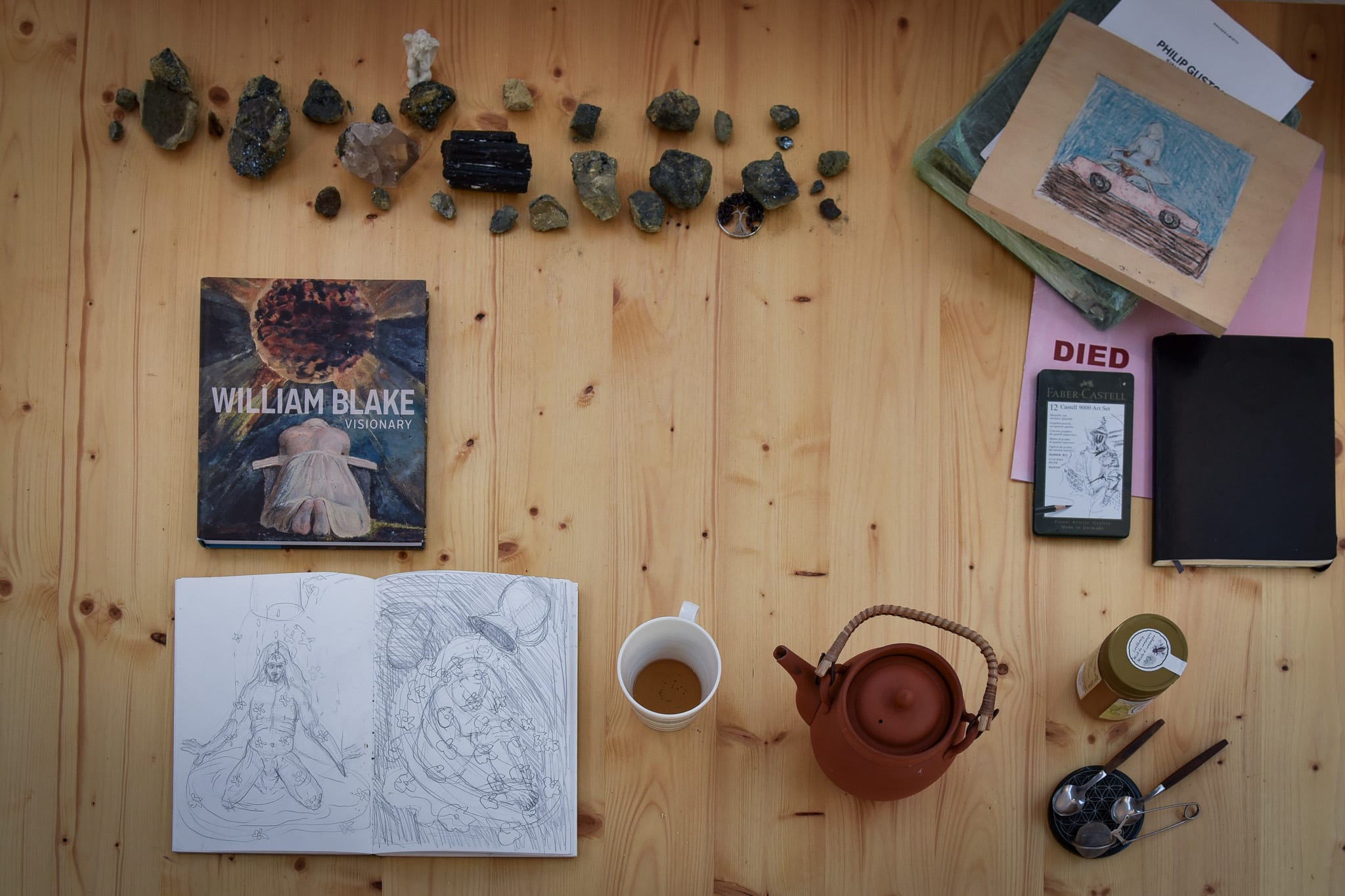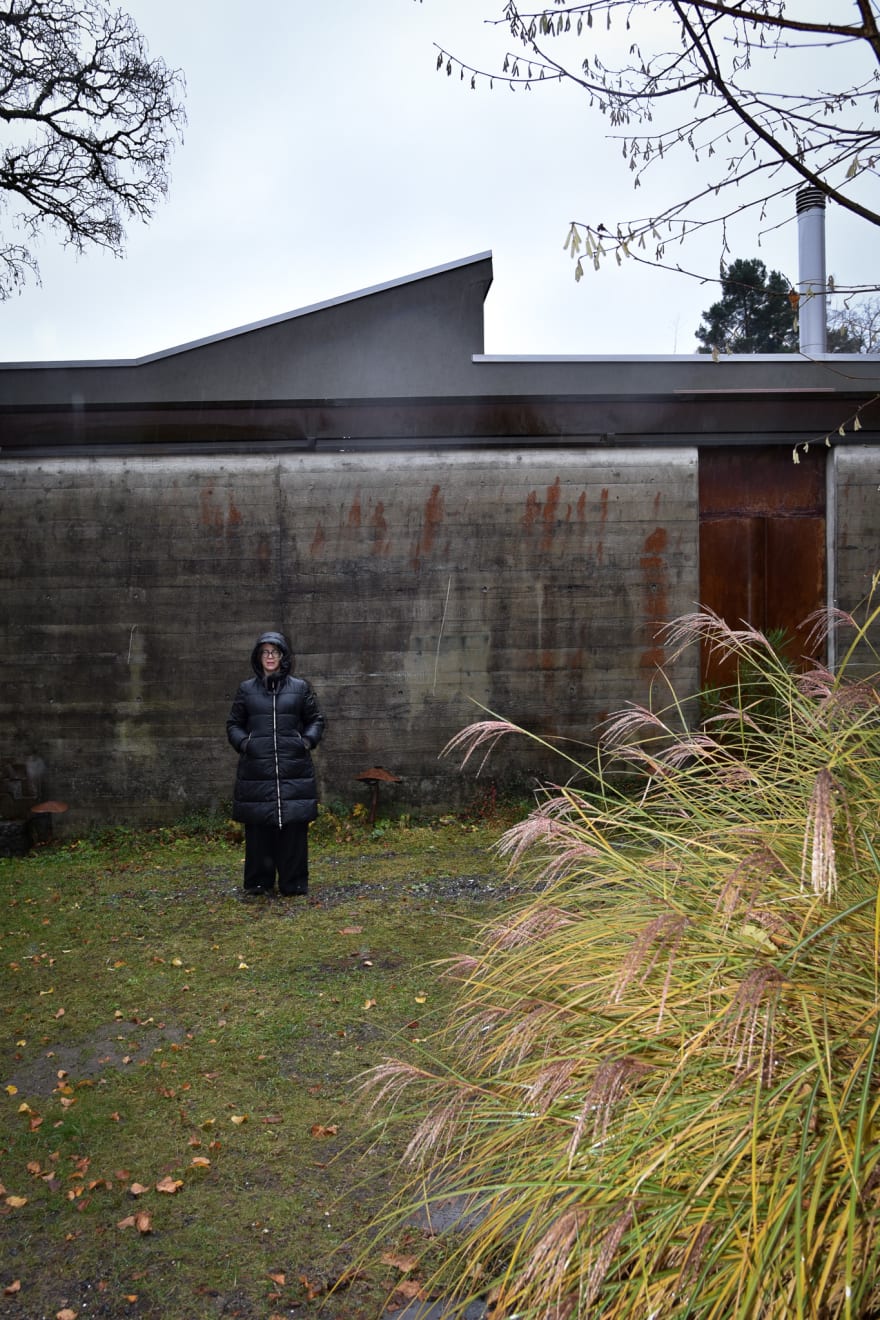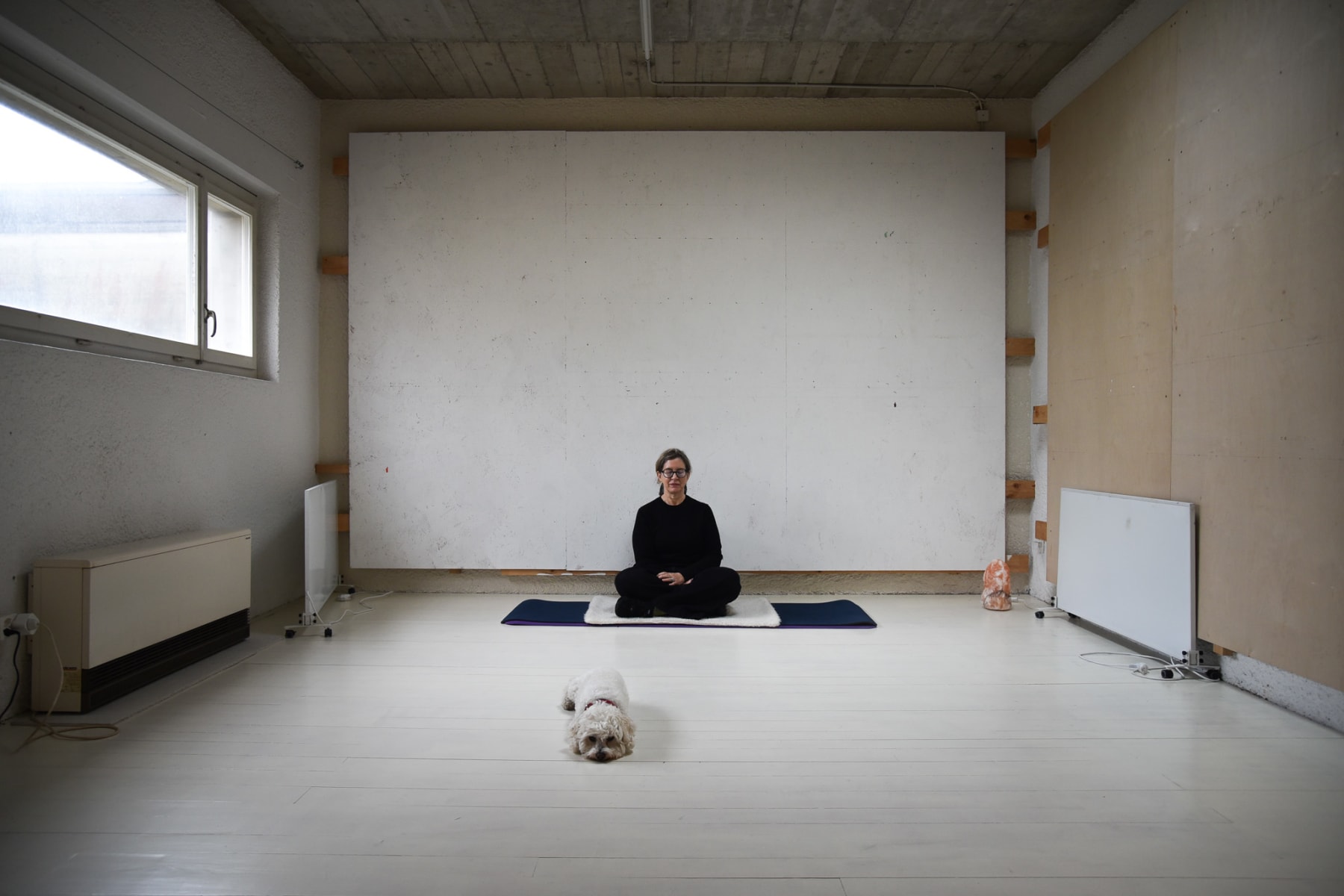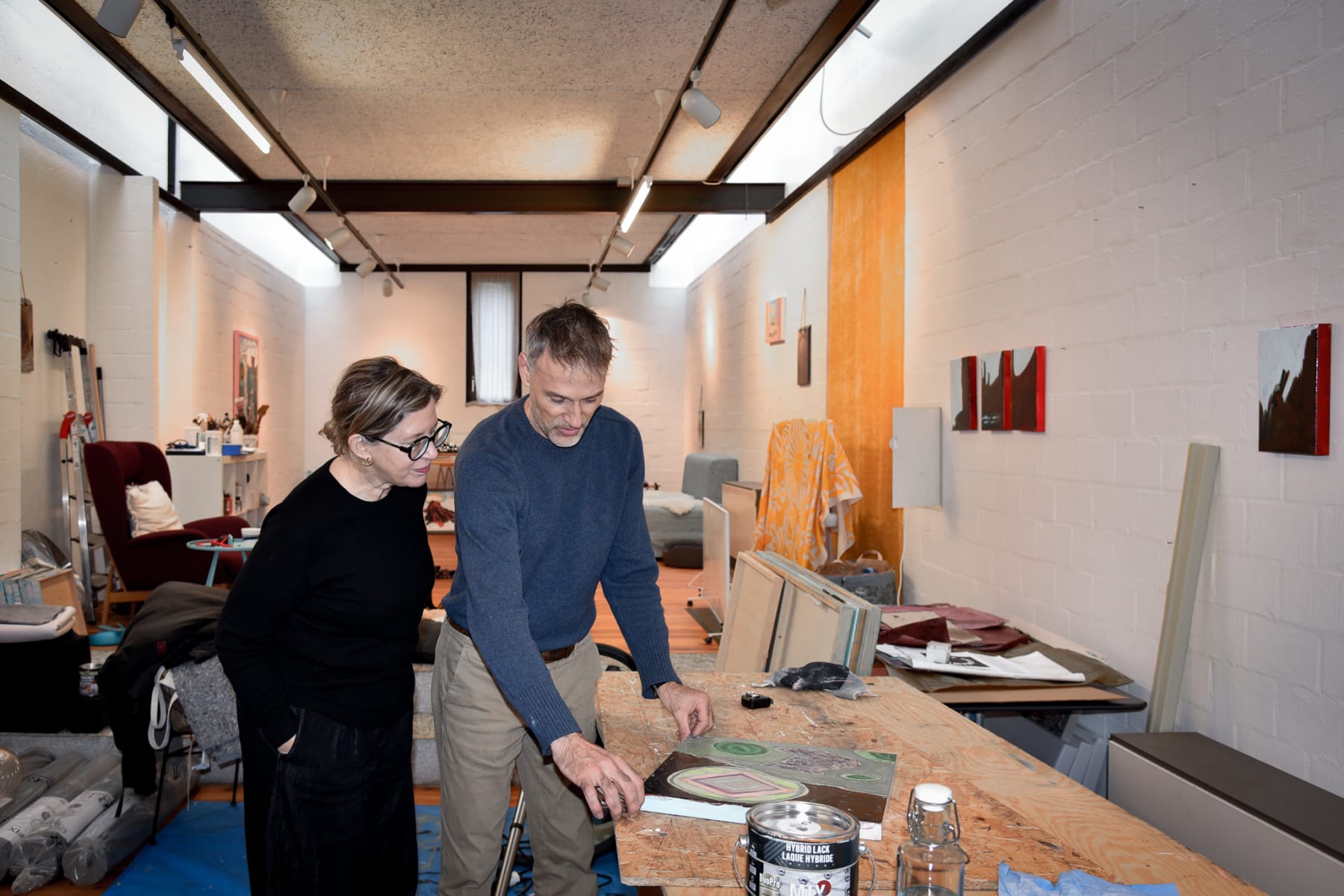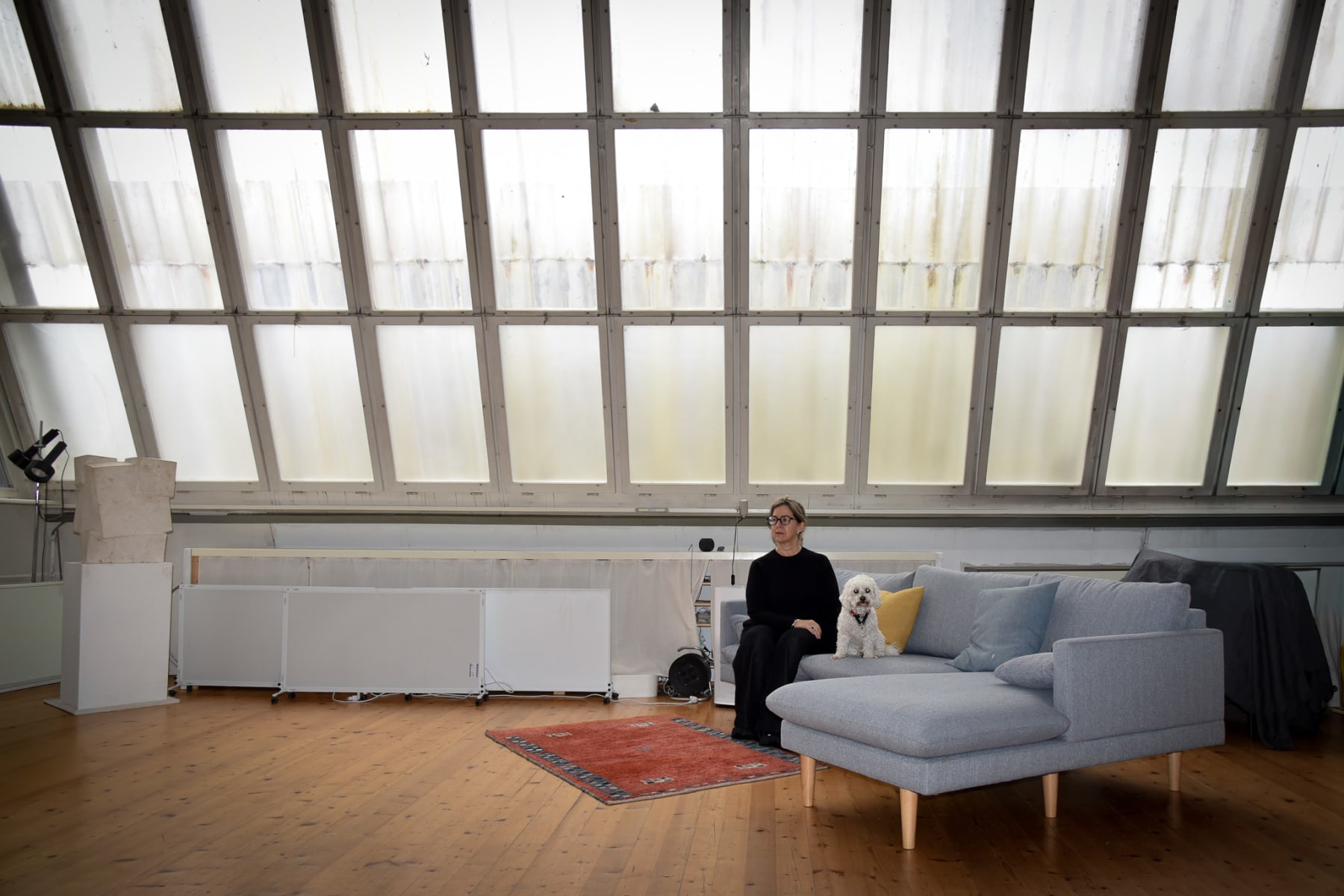It is a rainy autumn morning in Zurich when we arrive at Ann Tracy's studio in Gockhausen. The two buildings, designed by the renowned Swiss architect Eduard Neuenschwander, rise from the landscape like sculptural forms in raw concrete. They possess the same material strength that once defined the works of the sculptor Katharina Sallenbach, who created and worked here. The unheated volumes are illuminated by generous skylights that fill the rooms with natural light, creating an atmosphere of quiet intensity and clarity.
Today, the space is inhabited by Ann Tracy, whose presence has gently transformed its energy. The traces of Sallenbach's legacy remain visible, yet Tracy's use of color, gesture, and layered imagery brings a contemporary sensibility to the environment. What was once shaped for the weight of stone now holds the rhythm of painting, with wood panels leaning against the walls, pigments scattered across tables, and light shifting through the rooms in long, deliberate pauses.
Ann Tracy's practice weaves together narrative, symbolism, and material exploration. Her paintings often suggest mythological or dreamlike spaces where color, movement, and memory converge. Rooted in both emotional intuition and visual rigor, her work navigates the tension between the personal and the universal. In this conversation, we speak with her about process, influence, and the unique resonance of working in a space so charged with history and light.
171 GALLERY: Ann, this studio has a very distinct atmosphere. How does its architecture and the quality of light influence the way you work?
Ann Tracy: Great question, as I have recently moved within the buildings. Until this past summer (2025), I was working in what was once Kathrin's storage closet. There was a skylight and a long horizontal north-facing window. Certain times of day offered better lighting. I installed daylight fluorescent bulbs to help with the winter months and often added other lights, but there were moments each day, especially on sunny days, when the light became a beautiful bath with the sky overhead. It felt like a small way of communicating with the universe. Quite special.
We kept a separate building for yoga classes, and I've now moved my studio into that space. Each time I move studios, I need to get used to the quality of light and the times of day that suit my working rhythm. The former studio now used for yoga has a more sonically resonant atmosphere for that practice. My new studio space will take time to fully understand. It is much larger, giving me room to work on any project.
The light in this new space is very different. There are almost no traditional windows; instead, the ceiling is suspended, and windows run around the top of the building where the walls meet the roof. There are spotlights and fluorescent lights I plan to replace with daylight bulbs. Natural light shifts noticeably with time and weather. I still need to build working walls and find a cost-effective way to maintain a steady temperature. No workspace is perfect, but with time you can adjust almost any space. Adaptability is key.
Throughout my life I've worked in many kinds of studios-some huge, some tiny, some with no windows or even no electricity. You become part of each space's resonance, its sound, its history, its light.
171: Knowing that both buildings hold the legacy of the Swiss sculptor Katharina Sallenbach, and that you are related to her through your husband, the art therapist Michael Krauer, do you feel a sense of dialogue or continuity between her sculptural practice and your own?
AT: Regarding Kathrin, as we called her, I feel a deep sense of gratitude. I am proud that Michael and I can continue the traditions of art, yoga, and meditation in her spaces. I think she would be proud of us too.
Michael uses her former studio for his art therapy practice. It is a beautiful space with classic north-facing windows like the Parisian ateliers where Kathrin once studied. When she built her studio in three phases (1959, 1978, 1987), she specifically requested those windows. It gives his clients a rare and special experience.
Kathrin was a Zen practitioner and held a meditation group in her home. She was a very special person, and I feel fortunate to have known her. She was dedicated, always working as long as she could, and as a person, she was clear and truthful.
My work is very different from hers. She was a formalist, working in bronze and stone in Zurich, and she created another strong body of clay work in Italy. My background includes sculpture, but painting and printmaking are my central practices. For exhibitions, I often incorporate multimedia, sculpture, sound, and writing. My approach is very multi-modal.
Kathrin remains a guiding light to both Michael and me, but our bodies of work are profoundly different.
171: When you begin a new work, do you start with a clear idea, or does the painting unfold intuitively through experimentation and discovery?
AT: Both. I often begin with a clear idea that comes during meditation or while walking, cooking, or doing the dishes. I gather what I need, prepare the panels, or collect materials. Then comes the relationship with the materials and observing where the work wants to go.
A crucial part of the process is letting go of the initial idea so the work can become itself. Once I let go, the real dialogue begins.
171: Your paintings often merge imagination and memory into layered visual worlds. How do personal recollections or internal landscapes guide your imagery?
AT: I look at a lot of art and learn from it. My influences are wide and global. I often feel my ideas come from elsewhere, almost from above, through the crown chakra. Like many artists, I am tuned into the atmosphere of our times, and that influences me strongly.
The real challenge is speaking about contemporary life in a way that is direct yet slightly indirect, almost peripheral. The material itself has a voice that runs parallel to the conceptual space. There are many components, but in the end, it is just me and the brush, or the drill, or whatever tool the work demands.

Exhibition view from the solo show Transmissions, 2024. Photo: Pawel Streit
171: The surfaces of your works invite close observation. Can you describe how you build layers of paint and what you look for as each piece evolves?
AT: Building a painting takes time. I make certain decisions early on. Recently, I started ten paintings at once. Two days of gessoing, one day of acrylic underpainting, one day for a lean layer of paint. I never work on just one piece at a time; that's a recipe for disaster. Multiple works talk to each other. Small pieces support larger ones.
Once the early work is done, I sit and look a lot. Then I make moves. It's like chess. Once the first moves are in place, the work requires greater concentration and fewer gestures. Mind and body must collaborate. If one outruns the other, the painting closes too soon.
Layers go on and come off. Thinner layers first. I try to keep areas open even as others become more fleshy. I work to honor paradoxes.
171: Working on wood panels has a long tradition in painting and is central in your practice. What draws you to this material, and how does it shape your work?
AT: Wood keeps me closer to sculpture. It gives me a firmer landing for the brush. Canvas has a bounce I'm not always comfortable with. Wood is incredibly durable. Da Vinci's paintings on wood have stood the test of centuries.
On wood I can build more layers, carve, scrape, draw with the end of a brush. Wood can take a lot. It feels primal and alive. I'm grateful to the tree. Nature is the best artist. Working on wood brings that alive quality into the painting. A good painting breathes.
171: Do you think of your paintings as environments that hold emotion and narrative, or as intimate reflections of a state of mind?
AT: Probably both. Every brushstroke contains the moment in which it was painted: whether I took a walk, had a good meditation, what I ate, whether something was bothering me. It's all there. Each brushstroke is different, like a snowflake.
A painting becomes a collection of time and space, and also time outside time. A narrative quality returned to my work around 2016 when the figure reappeared. It let me speak more directly about the ideas that matter to me.
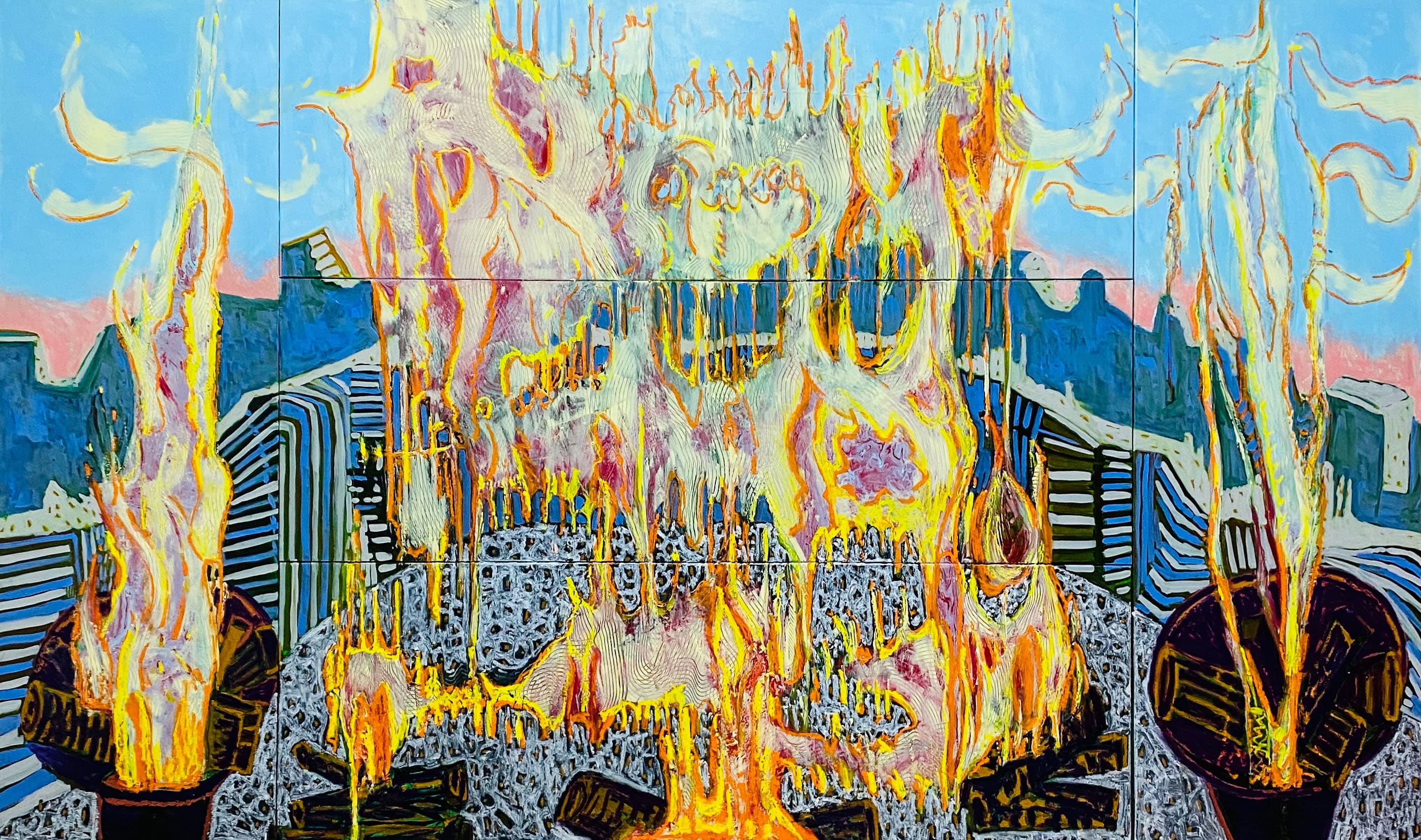
FIRE PUJA, 2023 Oil on panel 183 x 274 cm
171: How do you know when a painting is finished, especially when you work with such depth and layering?
AT: It takes a long time to know. Sometimes I push because I have a deadline, usually travel. I'll announce to Michael that it's done, and then come home with fresh eyes and realize it isn't.
To make strong work, I need to be both gentle and demanding with myself. Some pieces finish quickly; others take years. People ask how many hours a painting took, but the answer might be a lifetime.
Honesty is essential. When a painting is finished, it simply is. No area is left unaccounted for, even if it is empty. Emptiness is important.
171: Many of your works carry symbolic undertones. Are there recurring motifs or forms that hold personal or cultural meaning for you?
AT: Yes. When I'm between bodies of work, I paint feet, as though grounding myself. I believe in universal visual symbols and love C. G. Jung's work. Some symbols belong to all humanity.
There are personal symbols too. My body of work spans over forty years. I've thought about going through everything to map recurring forms, but it would take a year. Maybe one day. I can be slow to notice patterns. I often say I'm the last person to get my own jokes.
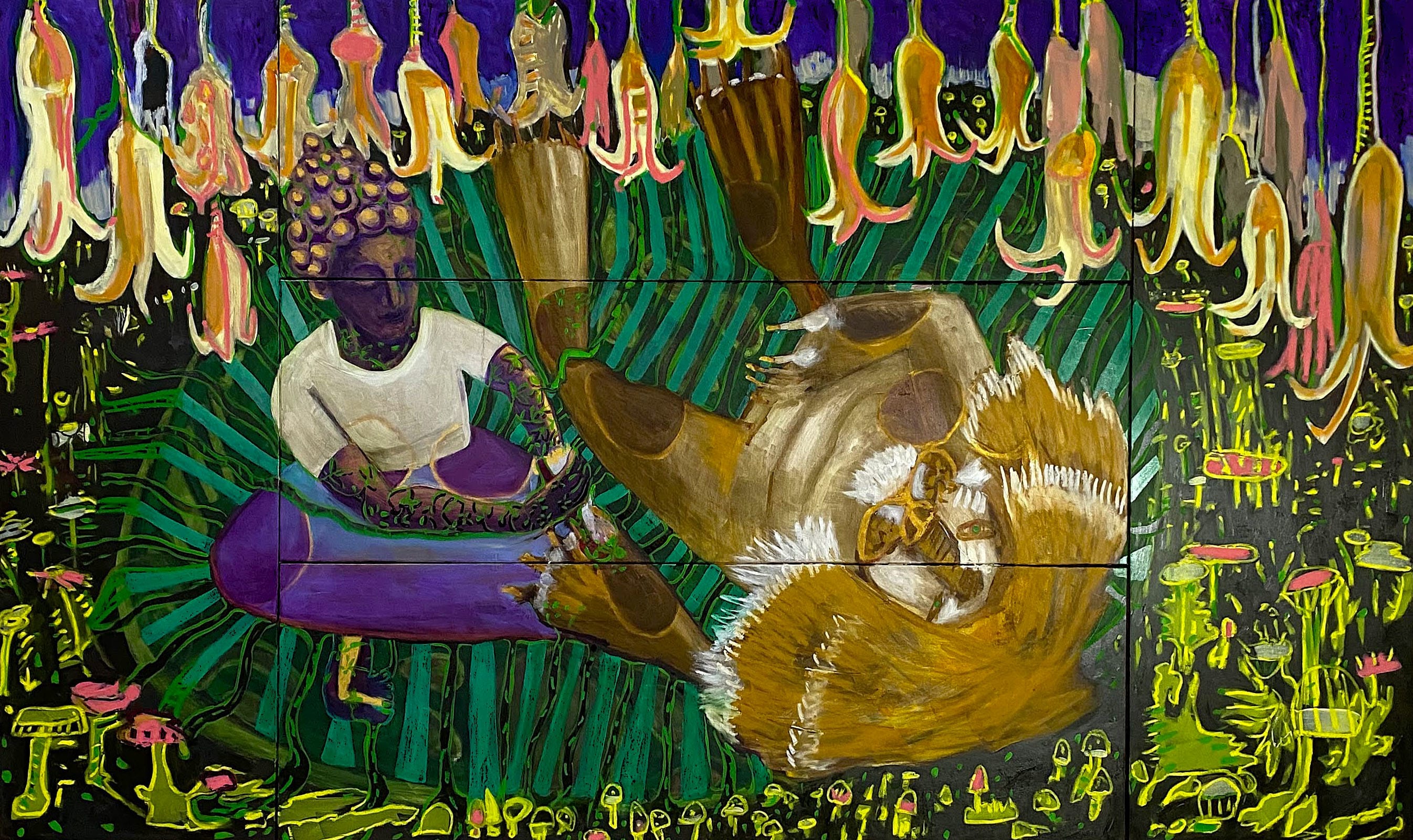
NIGHT TIME GARDEN II, 2022. Oil on wood panel, 159 × 220 cm. Private Collection.
171: Do you think about the viewer while you paint, or does your relationship with the work remain private until it is shown?
AT: My work stays private until it's seen. I have important paintings no one else has seen. The viewer completes the work.
I also keep some works for myself because I love them too much. They may look insignificant to others, but they hold something essential for me. They become talismans on the altar of my process.
171: You have lived and worked in many places, including Miami, Puerto Rico, Massachusetts, and New York. After so many environments, what does it feel like to be working now in Gockhausen, Zurich?
AT: It feels important to be here now. I'm studying German and immersed in Germanic culture. Life unfolds in surprising ways. When we're young, experiences can feel overwhelming. Later, patterns appear and the path becomes clear.
I feel I'm in a moment of doing my best work. I want to dig deeper. German has an earthy depth I appreciate, as I've noticed reading Paul Celan in both languages. Michael is deeply existential and holds me to my purpose.
I love nature, and Gockhausen is a gift. The forest is steps away. I swim in the lake. Returning to my work with focus and fewer interruptions feels like a blessing. I'm using my time well.
171: Every artist encounters moments of uncertainty or pause. How do you navigate those periods?
AT: I respect them. In graduate school, I listened to myself, even when professors disapproved. Sometimes I needed to walk for weeks. Then, when the time was right, I'd create a body of work in a burst.
Walking is meditation. I need to get the work into my body before making it. Travel, museums, teaching, yoga, writing-all of that is part of painting.
Family also matters. I trust myself and my process. Every year for forty-four years, I've made a body of work. Being an artist is a lifelong commitment. The ebbs and flows must be honored.
171: Are there new techniques, materials, or scales you are exploring or would like to explore?
AT: Absolutely. I've worked on a tight budget for years. Sometimes I think that if my work earned more than subsistence income, I'd do so much more. Art materials in Switzerland are extremely expensive. That's part of why art costs money.
People imagine the artist's life as romantic. It's actually hard work, sacrifice, intensity. It's wild and physical, like riding a bull with your soul. Rich and poor at once. Not for the faint of heart. But I wouldn't trade it.
171: Looking ahead, can you tell us about the ideas or directions guiding your upcoming body of work?
AT: Think Babel meets Haitian flower baths, expressed through an in-depth multimedia exploration. I'm working on it.
